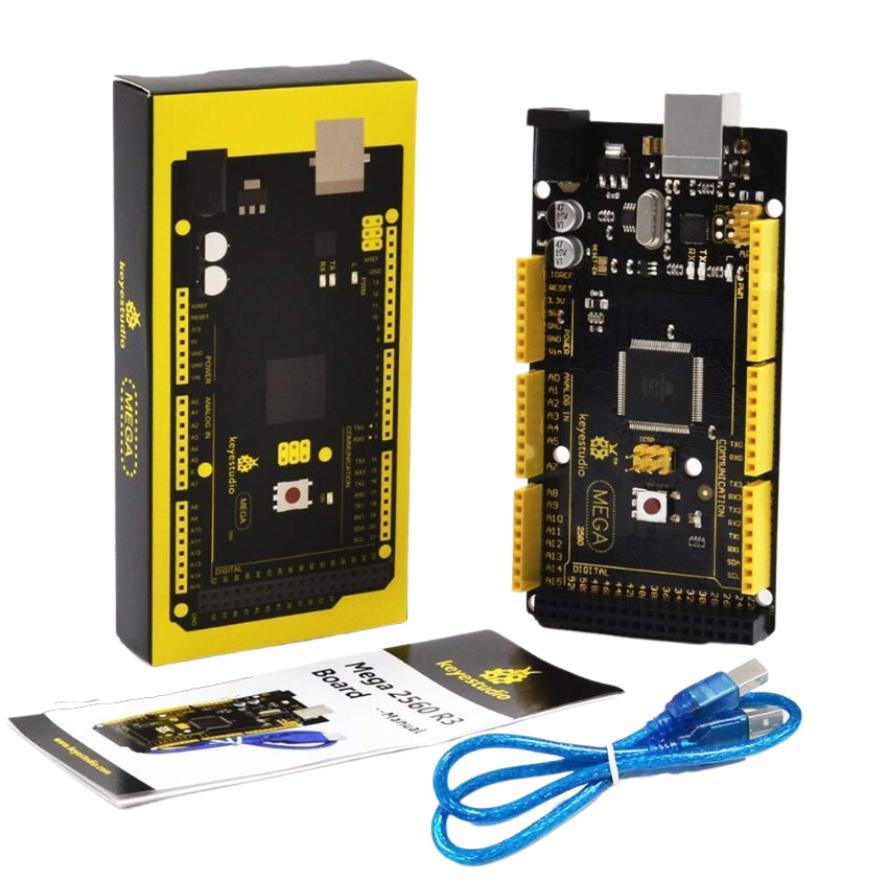Keyestudio Mega 2560
The all new Keyestuduio Mega 2560 is the first of its kind with a total of 54 digital I/O pins, of which 15 has the ability to generate PWM signals, 16 analogue inputs, 4 UARTs and a 16MHz crystal oscillator. It is programmed through a USB port connected to your computer making use of the Atmega16U2, which is programmed as a USB-to-serial converter, which is different from the Arduino Mega that makes use of the FTDI USB-to-serial driver chip.
The Mega 2560 is fully compatible with the Arduino Mega 2560 REV3. This means that you can use most of the shields that were created for Arduino microprocessors, which is convenient if you already have the shields that you need to do a project, but you do not have enough I/O pins on your microprocessor.
The Mega 2560 already has a bootloader built in on the board, to make it easy to program these microprocessors, because you now only need to plug the Mega 2560 into your computer via the USB cable and upload the code to the board. To make this process even simpler, you can use your Arduino IDE with code written for an Arduino directly on the Mega 2560 and only need to change the pin numbers.
After the Mega 2560 has been programmed, it remembers the code when it loses power. You can thus make use of a wide range of power supplies between 7V and 12V to power the microprocessor after the code has been uploaded, and it will still function on its own.

Technical specifications
| Processor | ATMEGA2560-16AU |
| Operating Voltage | 5 V |
| Recommended Input Voltage | 7V - 12 V |
| Digital I/O Pins | 15 (D2-D13; D44-D46) |
| Analogue Inputs | 16 (A0-A15) |
| I/O Pin max DC | 20 mA |
| 3.3V Pin max current | 50 mA |
| Flash Memory | 256 KB |
| SRAM | 8 KB |
| EEPROM | 4 KB |
| CLK Speed | 16 MHz |

| 1 | Digital Input/Output pins |
| 2 | Ground |
| 3 | AREF (Reference voltage, 0 - 5V) |
| 4 | SDA (IIC communication pin) |
| 5 | SCL (IIC communication pin) |
| 6 | In circuit serial programming header |
| 7 | USB connection |
| 8 | D13 LED |
| 9 | ATMEGA 16U2-MU |
| 10 | TX LED |
| 11 | RX LED |
| 12 | Crystal oscillator |
| 13 | Voltage Regulator |
| 14 | DC power jack |
| 15 | IOREF (Select the I/O voltage at which the board operates |
| 16 | Reset header |
| 17 | 3.3V Power pin (max 50mA) |
| 18 | 5V Power pin |
| 19 | 7 - 12V Vin |
| 20 | Analog pins |
| 21 | Reset button |
| 22 | In circuit serial programming header |
| 23 | Microcontroller |
| 24 | Power LED indicator |
For more microprocessors also look at:
Arduino Mega, Arduino Uno, Arduino Nano, ESP32, Rasberry PI Pico, Lichee PI
